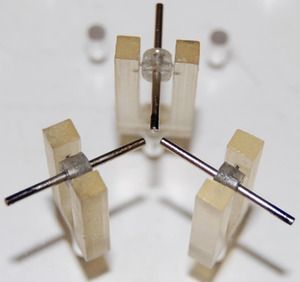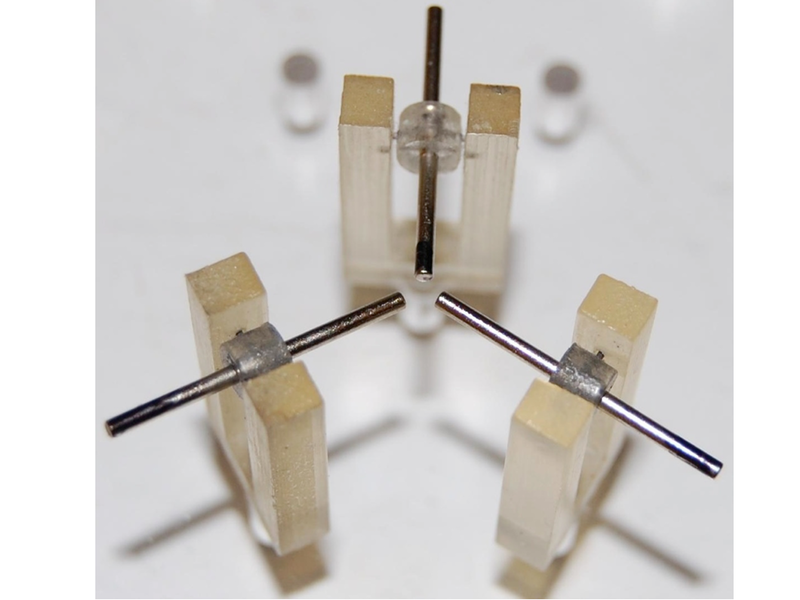Atomic Spins at Human Scale
A research team publishing in Physical Review Letters has used an array of bar magnets mounted on individual hinges to study magnetic interactions among atomic spins in solids. The researchers analyzed the responses of the bar magnets to two types of magnetic field disturbance and found that the system works as a model of materials called spin ices, despite the presence of classical effects such as friction. The team says the magnet array will allow a wide range of new spin ice experiments, which may be important as researchers try to incorporate these materials into future magnetic memory devices.
Spin ices are a class of materials where the magnetic moments (spins) on the atoms interact with one another, and researchers hope to manipulate these spins to store digital information. In the spin ice structure, the atoms form tetrahedrons, and you can think of the spins as arrows on the atoms pointing toward or away from the center of each tetrahedron. Neighboring spins prefer to have opposite orientations, but in the tetrahedral structure, there is no way to satisfy every spin—the system is “frustrated.” Each tetrahedron will have two spins pointing in and two pointing out. The various ways of arranging the four spins into this two-in/two-out configuration are called the “spin ice rules.”
To study frustration in more detail, researchers have recently constructed larger scale versions of spin ices using entire magnetic domains containing many atoms to represent the individual spins [1,2]. These domains, which could be nanometers across, were arranged in a two-dimensional honeycomb of hexagons, rather than D tetrahedra. In this artificial spin ice, three spins meet at each vertex, and the spin ice rules require two-out/one-in or one-out/two-in. Researchers have measured the local magnetic fields and the effects of external fields, for example, but the nanosecond responses of the domains have been too quick to see with current imaging techniques.
L. Mahadevan of Harvard University and his colleagues sought to follow individual spins responding to frustration, so they built a macroscopic model. They constructed a square-meter grid of -centimeter-long bar magnets that could rotate vertically on individual hinges placed in a honeycomb arrangement. While one other research team has constructed a frustrated system of bar magnets (a form of frustration different from spin ices), they had not analyzed the system in motion, which Mahadevan’s team felt was essential [3].
In their first experiment, Mahadevan’s team applied a strong magnetic field in the vertical direction, out of the plane of the array, to align all of the bar magnets with their north poles up. When they turned the external field off, the magnets immediately began spinning, then oscillating, and within about seconds, the magnets stabilized into a classic spin ice pattern, with all of them lying close to the plane of the array. Mahadevan says that this equilibrium state, with the magnets in-plane and following the spin ice rules, wasn’t a sure thing, since no one had made a macroscopic spin ice before.
The team analyzed high speed video of this experiment, measuring the degree of alignment of neighboring magnets over time. They found that the early rapid motion of the magnets was due to the strong interactions among them, whereas the final dwindling oscillations before equilibrium were determined by hinge friction. In their second experiment, the researchers started with the array at equilibrium and then moved a large bar magnet at a fixed distance and velocity, below and parallel to the array. The closer and slower the external magnet was, the more effect it had on the magnets in the array. All of the results were consistent with the team’s computer simulations.
The large-scale spin ice model opens up new possibilities for highly controlled experiments where one can observe “the state of the magnetic system in real time” and follow the response of a single spin, says team member Paula Mellado. Oleg Tchernyshyov of Johns Hopkins University in Baltimore says the recent studies of nanoscale magnets also addressed the problem of getting at the details of spin ice phenomena, “but these guys are taking it to the next level.”
–Halleh B. Balch
Halleh B. Balch is a science writing intern at APS and also a physics researcher and freelance science writer.
References
- R. F. Wang et al., “Artificial ‘Spin Ice’ in a Geometrically Frustrated Lattice of Nanoscale Ferromagnetic Islands,” Nature 439, 303 (2006)
- Y. Qi, T. Brintlinger, and J. Cumings, “Direct Observation of the Ice Rule in an Artificial Kagome Spin Ice,” Phys. Rev. B 77, 094418 (2008)
- E. Y. Vedmedenko, H. P. Oepen, and J. Kirschner, “Decagonal Quasiferromagnetic Microstructure on the Penrose Tiling,” Phys. Rev. Lett. 90, 137203 (2003)





